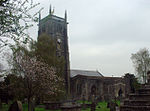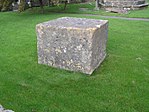Chew Magna Reservoir

Chew Magna Reservoir is a 5-acre (2 ha) reservoir on the western outskirts of the village of Chew Magna, Somerset, England. It lies just north of the B3130 Winford Road. The reservoir was created by damming Winford brook in order to supply water for villages in the Chew Valley. It is owned and managed by Bristol Water. Chew Magna reservoir provides fly fishing for stocked brown trout (Salmo trutta morpha fario) and rainbow trout (Oncorhynchus mykiss). Rainbows can be fished all year. Parking is close to the lake and there are many stagings erected around the lake. In 2011 the reservoir emptied following a long period without sustained rainfall. Bristol Water rescued the trout and transferred them to the nearby Chew Valley Lake.
Excerpt from the Wikipedia article Chew Magna Reservoir (License: CC BY-SA 3.0, Authors, Images).Chew Magna Reservoir
Winford Road,
Geographical coordinates (GPS) Address Nearby Places Show on map
Geographical coordinates (GPS)
| Latitude | Longitude |
|---|---|
| N 51.366 ° | E -2.626 ° |
Address
Winford Road
Winford Road
BS40 8QQ
England, United Kingdom
Open on Google Maps









